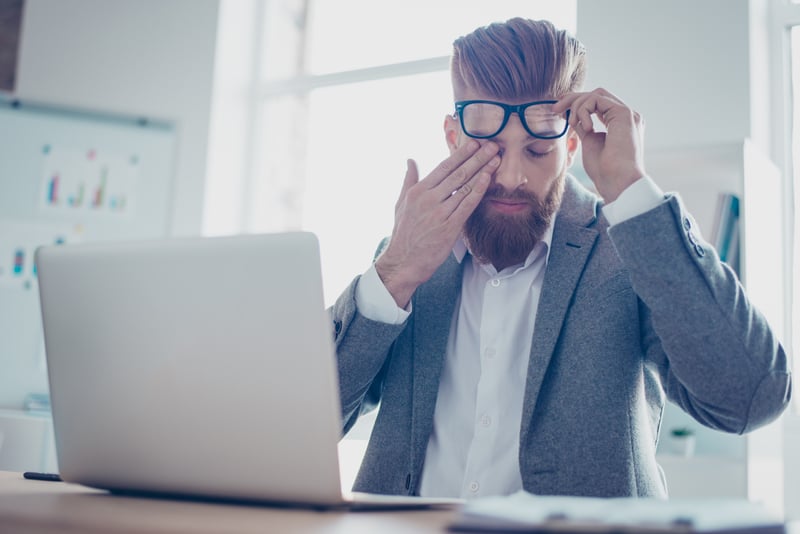Why Am I So Tired in the Afternoon? See the Science

–Always-Tired Amanda
A: Excuse me… did you say something? I was starting to doze off for an afternoon nap. Yawn… stretch… Ah… that was refreshing…
Okay. I’m all caught up now, and you say you’re tired in the afternoon, Amanda? I feel you! And guess what? That is completely understandable and makes you, well, human.
See, it’s entirely normal to feel sleepy mid-day.
That doesn’t, however, make it fun. In fact, afternoon slumps can be frustrating, especially if you need energy to finish a long list of to-do’s before you can stop working for the day.
Trying to just power through and get it done, regardless of how exhausted you feel, isn’t a good idea. How productive can you actually be when you can barely keep your eyes open, your brain feels like you’re in a cloud, and you have the attention span of a sloth trying to decide what leaf to eat?
You know you could get so much more done if you could just get past the afternoon slump and re-energize for the afternoon. If only you could find the motivation…
Why Do We Experience an Afternoon Slump?
Afternoon sleepiness is just a part of human nature. Our energy levels go up and down throughout the day in response to our circadian rhythms. One main energy dip is when the majority of us are sleeping—between midnight and dawn. Of course, right? Yet most of us also experience a second, smaller dip between 1:00 p.m. and 4:00 p.m.
During this time, we tend to experience a slight dip in core temperate, just as we experience before bedtime, and this dip can signal the brain to release more melatonin. This post-lunch, or postprandial, dip varies from person to person, but for many of us, there’s a noticeable afternoon slump of concentration and alertness or just feeling downright sleepy.
This is the perfect time for an afternoon siesta (aka nap) for about 20 minutes. While this may just be part of the day in Spain, Italy, and other parts of the world, in modern American society, even a short afternoon nap is not always realistic or practical—it can even be frowned upon.
How to Overcome Afternoon Sleepiness
If you can’t just succumb and enjoy a short snooze to rejuvenate yourself for a more productive and enjoyable afternoon, there are other simple steps to help you reclaim your energy.
1. Watch What You Eat. When you’re tired, you may try to reach for food to give you a bit more pep. Unfortunately, many of us tend to reach for high-sugar, high-carb, high-calorie, low-nutrition foods. These will give you a bit more energy, yes. Unfortunately, that energy boost is all too fleeting, leaving you feeling more drained than before you ate.
If you are experiencing an afternoon slump, food can help provide the energy you need. It starts, however, with what you consume for lunch. For energy that will last throughout the afternoon, ensure you are getting a balance of protein, carbohydrates, and fat. This can help keep your blood sugar levels steady and maintain levels of key amino acids, so your body and mind have the fuel they need. You don’t, however, want to overeat. Switching to a smaller meal at lunch may help prevent an afternoon slump.
And if you do find yourself hungry in the afternoon, snack smartly on foods that give you energy. Choose fresh fruits like bananas or apples, for example, or a small serving of nuts (such as walnuts, almonds, or cashews), seeds (such as pumpkin or hemp), or even some avocado.
2. Drink up. Even mild dehydration—just 1.5% of your body’s water—can make you feel sluggish, tired, and moody. Keep a bottle of water with you to sip throughout the day. If you don’t “love” the flavor of water, fill up a pitcher in the fridge with water and some slices of lemon, lime, orange, cucumber, or berries for an even more refreshing and energizing beverage. Either way, shoot for at least eight cups of water throughout the day.
3. Exercise. It may sound counterintuitive, but exercise is a well-known energizer. Even a mini mid-day workout (or exercise snack) can help you overcome drooping energy levels. Try a quick walk or run or even a 5- to 10-minute body-weight workout, yoga practice, or stair climb.
Even if you can’t physically leave your workplace, get up and move your body around every hour throughout the day, especially if you’re required to sit at a desk. Stand up, stretch, or walk around a bit before getting back to work. Or, give these deskercise options a try.
4. Step into some sun. To remind your body that it’s day rather than night, get out into the sun. Even just a few minutes can help increase your body temperate and signal the body not to release sleep-promoting melatonin. Getting some sunshine for 15 to 20 minutes can be even better. And if you combine it with a walk, you can enjoy even more of an energy boost.
Better yet, take a walk in the sunlight before you start experiencing an afternoon slump. If you know sleepiness starts to hit you around 2:00 every day, for example, slip on your sneakers and get out into the sunlight at 1:30.
Sometimes, though, it can be impossible to get outside to enjoy some sunlight. In that case, see if you can sit either next to a window or under a bright light to help energize you.
5. Turn on some tunes. If you are dragging through an afternoon slump, the solution may be as simple as listening to some upbeat muscle. Need to focus? Choose music without lyrics. You can find countless choices on Spotify, Pandora, or YouTube.
6. Try something new. If you’re working on the same report for hours on end and find your eyes glossing over, then try switching gears to help stimulate your mind. Make some phone calls, answer some emails, or work on another project for a while. Then come back to that report with fresh eyes and a rejuvenated mindset.
7. Give your eyes a break. How long have you been staring at the same screen? Every 20 minutes, gaze at an object (or nature!) that’s at least 20 feet away for at least 20 seconds. (This is known as the 20/20/20 rule, and it’s a good one to follow to prevent eyestrain and keep your mind alert.)
It’s also a good idea to ensure you aren’t too close to your computer screen. A safe distance is about an arm’s length away.
8. Supplement. While there are stimulant-filled supplements available that claim to provide quick energy, they may not be the best thing long term. Instead, look for supplements that offer adaptogenic herbs like Ginseng, Ginkgo biloba, Maca, Rhodiola rosea, or Ashwagandha to help support energy levels without making you feel jittery or edgy. Other non-stimulating nutrients that help support mental energy, concentration, and cognitive functioning include B12, acetyl-l-tyrosine, acetyl-l-carnitine, and L-theanine, which can all be found in Brain Bright®.
9. Go green. Green tea, that is. While coffee gets all the credit for being a pick-me-up, green tea may be even better. That’s because it can help perk you up during the day without keeping you up throughout the night. Plus, it’s filled with phytochemicals that can boost health. Green tea can be an acquired taste, so if it doesn’t tickle your taste buds right off the bat, you can try it mixed with various flavors like mint, lemon, mango, cherry, jasmine, or even Earl Grey. Mint tends to be one of the most energizing.
Speaking of mint, peppermint essential oil is often used to promote focus, concentration, and alertness. You can dab a drop on the inside of your wrist, or you can diffuse a few drops in your office.
10. Get social. Have you been stuck at your desk or station alone and find your mind drifting off toward dreamland? What you may need is a moment of connection. Take a minute or two to chat with a friend, co-worker, or even a stranger. The social fix can give your mind a break from the daily monotony. Even if you can’t chat in person, you can enjoy a phone call, Facetime, or message to a loved one. Social interactions can also “energize” you by raising levels of excitatory neurotransmitters, such as dopamine.
11. Chew gum. Not only can chewing sugar-free gum help keep your mouth fresh, it can also help keep your brain fresh. Studies have found that gum chewing not only boosts energy but can also improve work performance.
12. Cool off. While not always possible when you’re at your office, if you can, take a minute to chill out. Splash some cool water on your face, stand in front of the freezer or AC, or even take a quick cold shower to make you much more alert… fast!
13. Go the F to sleep… at night. While you may be in bed for eight hours every night, are you getting quality sleep during that time? Ensure you are with these six easy steps.
Overcoming an Afternoon Slump: A Recap
Still feeling tired? If all else fails, sneak off to a quiet corner—maybe even your car—and close your eyes for a 10- to 20-minute break. If you can nap, great. If not, just relaxing your mind, or better yet, meditating, may give you that boost to blast through your afternoon tiredness, so you can get back to being happy, energetic, and productive. Avoid napping for longer than 20 minutes, though, as longer naps can leave you feeling groggy rather than refreshed and make it harder to sleep at night.
If you’re still tired after trying the tips above, or if you always feel sleepy, it’s time to visit your doc. You may have an underlying health issue (such as anemia, low-grade infection, depression, sleep apnea, or others) that could be causing your afternoon slump.








